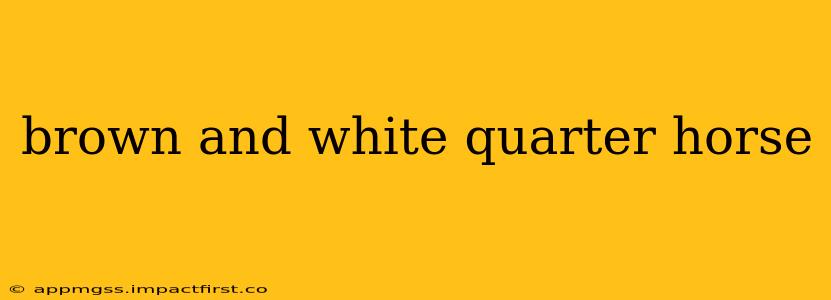The American Quarter Horse, known for its versatility and athleticism, comes in a breathtaking array of colors. Among the most striking is the combination of brown and white, showcasing a captivating contrast that catches the eye. This article delves into the beauty and variations of brown and white Quarter Horses, exploring their markings, genetics, and the unique appeal they hold for riders and enthusiasts.
What are the Different Types of Brown and White Quarter Horse Markings?
Brown and white Quarter Horses exhibit a wide spectrum of markings, each contributing to their individual uniqueness. These markings can range from subtle splashes of white to extensive patterns covering significant portions of their bodies. Common markings include:
- White socks/ stockings: These are common and range from small patches above the hooves to substantial white markings extending up the legs.
- White blaze: A broad white stripe down the face, often extending onto the forehead.
- White snip: A smaller white marking on the nose.
- White star: A small, often star-shaped marking on the forehead.
- White face: Extensive white markings that cover a large portion of the face.
- Chestnut and White: A variation within the brown family, where the brown base is a rich, reddish-brown, often coupled with white markings.
- Bay and White: Although technically a different base coat, Bay (reddish-brown with black points) can produce striking color combinations with white markings.
- Tobiano: This is a specific coat pattern characterized by large, rounded patches of white that often cross the back and usually involve white legs.
- Overo: In contrast to Tobiano, Overo patterns are characterized by irregular, blotchy white markings, often with the white not crossing the back. There are various types of Overo patterns (e.g., frame, sabino, etc.).
How are Brown and White Markings Inherited in Quarter Horses?
The inheritance of coat color and markings in Quarter Horses is complex, governed by multiple genes interacting in intricate ways. While pinpointing the exact genetic combination responsible for a specific brown and white pattern is difficult, it’s generally understood that several genes influence the base coat color (brown in this case) and the distribution of white markings. These genes are passed down from parents to offspring, resulting in the diverse array of colors and patterns observed in the breed. Understanding the specific genetics requires specialized knowledge in equine genetics.
Are Brown and White Quarter Horses More Prone to Certain Health Issues?
The coat color and markings of a Quarter Horse do not directly indicate a predisposition to specific health issues. However, it's crucial to remember that all horses, regardless of color, can be susceptible to certain conditions. Responsible breeding practices and careful health management remain essential for ensuring the well-being of any horse, including brown and white Quarter Horses. Regular veterinary check-ups, appropriate nutrition, and a safe environment are crucial for maintaining the horse's overall health.
What Makes Brown and White Quarter Horses Unique?
The striking combination of brown and white creates a visually appealing contrast, making these horses instantly recognizable and highly sought after. The unique patterns and variations in markings further enhance their individuality. This combination often exudes elegance, strength, and a certain majestic quality. The versatility of the Quarter Horse breed, combined with the captivating aesthetics of this color combination, creates a truly exceptional animal.
What is the Temperament of a Brown and White Quarter Horse?
The temperament of a Quarter Horse is not determined by its coat color. Quarter Horses are generally known for their intelligence, gentle nature, and willingness to work, regardless of their markings. Individual temperaments can vary, influenced by factors such as genetics, training, and handling. A well-trained and socialized Quarter Horse, regardless of its coat color, will typically display a calm and cooperative demeanor.
How Much Does a Brown and White Quarter Horse Cost?
The price of a Quarter Horse, including those with brown and white markings, varies significantly depending on factors like lineage, training, age, and conformation. A well-bred show horse with superior bloodlines will command a higher price than a horse bred primarily for pleasure riding. Researching reputable breeders and understanding the horse's history is crucial when considering a purchase.
This detailed exploration of brown and white Quarter Horses highlights their captivating beauty and diverse characteristics. Their unique markings, combined with the inherent versatility and athleticism of the breed, make them truly exceptional equine companions. Remember, responsible ownership and careful consideration of the horse's individual needs are paramount.
